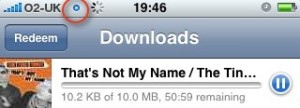Macworld has just finished and to be honest, the keynote was a bit underwhelming. The BBC has declared that Apple fizzled out, iPhone Central believes iPhone news was a no-show for Expo keynote, and our own Steve Litchfield thinks that the iPhone is in stasis.
While there may have been no new hardware announcements (where art thou, iPhone Nano?), the iPhone isn’t really about the hardware. Its main pull is the software, and the ecosystem in which it operates.
 The blogosphere is awhoop that iTunes has now gone DRM-free. But the important news for iTunes and the iPhone today is the fact that you can now download songs – anywhere. Apple has enabled the downloading of iTunes content on the iPhone, using a mobile network. Both 3G and GPRS data connections are supported. As you can see in the screenshot, I was able to buy a track over GPRS. When I switched 3G back on – the App Store stopped momentarily, then resumed downloading the track and completed in a few minutes. As with the App Store, anything over 10MB requires a Wifi connection; that’s not such a problem for music as most tracks are smaller than 10MB.
The blogosphere is awhoop that iTunes has now gone DRM-free. But the important news for iTunes and the iPhone today is the fact that you can now download songs – anywhere. Apple has enabled the downloading of iTunes content on the iPhone, using a mobile network. Both 3G and GPRS data connections are supported. As you can see in the screenshot, I was able to buy a track over GPRS. When I switched 3G back on – the App Store stopped momentarily, then resumed downloading the track and completed in a few minutes. As with the App Store, anything over 10MB requires a Wifi connection; that’s not such a problem for music as most tracks are smaller than 10MB.
The mobile networks have been won over
I’m sure that allowing mobile iTunes purchases has only happened with the mobile carriers’ agreement. Their mobile bandwidth is a precious and expensive commodity. In April, I wrote in “There’s something else in the air” that I couldn’t see carriers allowing music and video to be synced over the air (OTA). But mobile purchasing of music is different. It’s a one-time transaction – you pay and then you download a track, that’s it. So the bandwidth requirements are going to be far less than with constant syncing. They’ve already conceded the idea of a mobile store – the App Store – and we all know how well that’s going. Plus, there’s probably some additional revenue-sharing going on.
Music, wherever
Let’s face it – until recently, buying mobile music has sucked. I don’t mean buying music on a computer then sideloaded, I mean buying music on the device when you’re out and about. The carrier’s own on-device stores are between poor and plain awful. And you often had to pay for the additional data as well.
There are really only two other on-device services comparable to iTunes on the iPhone: the Nokia Music Store, and Amazon MP3 on the T-Mobile G1. The Amazon MP3 store is restricted to buying music over wifi only, although, you can browse and preview music over 3G. But you can buy on Nokia’s Music Store using any data connection – see this Symbian World link for a demo. Additionally, the Zune marketplace is coming to Windows Mobile phones, but probably not until the end of 2009.
So yesterday’s move to do away with the artifical Wifi-only restriction puts Apple, the iPhone platform, and iTunes on a par with Nokia, S60 and the Nokia Music Store. iTunes also has the advantage that the majority of music on iTunes is now DRM-free, although I’m sure Nokia will switch to DRM-free as well in due course (with the exception of the Come with Music offering).
An over-the-air component to mobile iTunes will facilitate many more impulse purchases, and reinforces the iPhone as an excellent media consumption device. It’s also a step to the future – one which Nokia has already taken. As MP3 players increasingly converge with phones, will we soon wonder why anyone downloaded songs on a computer first? Probably not for a while, as sideloading ripped CDs is currently cheaper. But as physical media dies out, I believe over-the-air downloads will become the way most people buy and enjoy their music.
